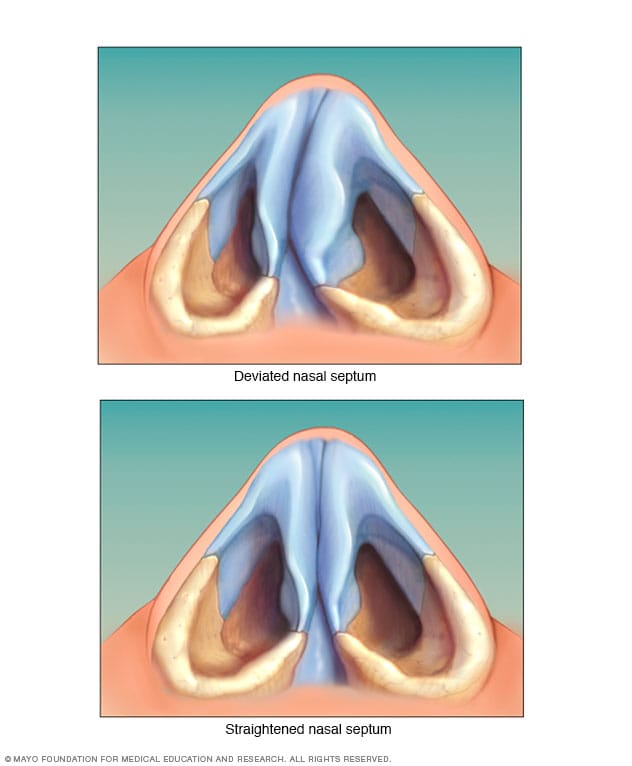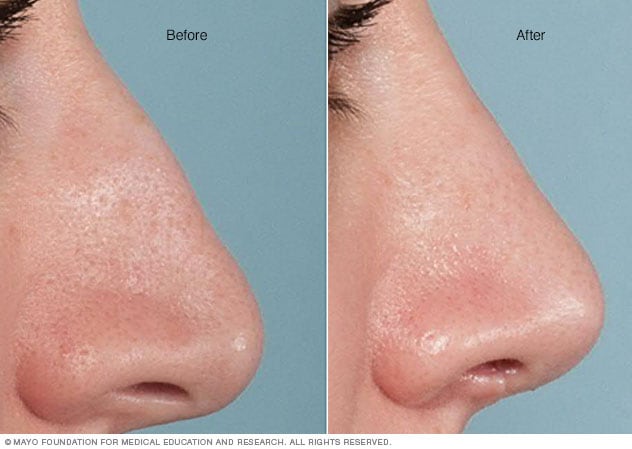Deviated septum
Overview
A deviated septum occurs when the thin wall (nasal septum) between your nasal passages is displaced to one side. In many people, the nasal septum is off-center — or deviated — making one nasal passage smaller.
When a deviated septum is severe, it can block one side of the nose and reduce airflow, causing difficulty breathing. The exposure of a deviated septum to the drying effect of airflow through the nose may sometimes contribute to crusting or bleeding in certain people.
A nasal blockage or congestion (obstruction) can occur from a deviated nasal septum, from swelling of the tissues lining the nose or from both.
Treatment of nasal obstruction may include medications to reduce the swelling. To correct a deviated septum, you'll need surgery.

Symptoms
Most septal displacements result in no symptoms, and you may not even know you have a deviated septum. Some septal deformities, however, may cause the following signs and symptoms:
- Obstruction of one or both nostrils. This blockage can make it difficult to breathe through the nostril or nostrils. You may notice this more when you have a cold or allergies that can cause your nasal passages to swell and narrow.
- Nosebleeds. The surface of your nasal septum may become dry, increasing your risk of nosebleeds.
- Facial pain. There is some debate about the possible nasal causes of facial pain. A possible cause of one-sided facial pain could be a severe deviated septum in which surfaces within the nose touch and cause pressure.
- Noisy breathing during sleep. A deviated septum or swelling of the tissues in your nose can be one of the many reasons for noisy breathing during sleep.
- Awareness of the nasal cycle. The nose alternates between being obstructed on one side and then changes to being obstructed on the other. This is called the nasal cycle. Being aware of the nasal cycle isn't typical and can indicate nasal obstruction.
- Preference for sleeping on a particular side. Some people may prefer to sleep on a particular side to optimize breathing through the nose at night if one nasal passage is narrowed.
When to see a doctor
See your doctor if you experience:
- A blocked nostril (or nostrils) that doesn't respond to treatment
- Frequent nosebleeds
- Recurring sinus infections
Causes
A deviated septum occurs when your nasal septum — the thin wall that separates your right and left nasal passages — is displaced to one side.
A deviated septum can be caused by:
- A condition present at birth. In some cases, a deviated septum occurs when the fetus develops in the womb and is apparent at birth.
-
Injury to the nose. A deviated septum can also be the result of an injury that causes the nasal septum to be moved out of position.
In infants, such an injury may occur during childbirth. In children and adults, a wide array of accidents may lead to a nose injury and deviated septum. Trauma to the nose most commonly occurs during contact sports, rough play such as wrestling or automobile accidents.
The aging process may affect nasal structures, worsening a deviated septum over time.
Swelling and irritation of the nasal cavities or sinus cavities because of an infection can further narrow the nasal passage and result in nasal obstruction.
Risk factors
For some people, a deviated septum is present at birth — occurring during fetal development or due to injury during childbirth. After birth, a deviated septum is most commonly caused by an injury that moves your nasal septum out of place. Risk factors include:
- Playing contact sports
- Not wearing your seat belt while riding in a motorized vehicle
Complications
A severely deviated septum causing nasal blockage can lead to:
- Dry mouth, due to chronic mouth breathing
- A feeling of pressure or congestion in your nasal passages
- Disturbed sleep, due to the unpleasantness of not being able to breathe comfortably through your nose at night
Prevention
You may be able to prevent the injuries to your nose that can cause a deviated septum with these precautions:
- Wear a helmet or a midface mask when playing contact sports, such as football and volleyball.
- Wear a seat belt when riding in a motorized vehicle.
Diagnosis
During your visit, your doctor will first ask about any symptoms you may have.
To examine the inside of your nose, the doctor will use a bright light and sometimes an instrument designed to spread open your nostrils. Sometimes the doctor will check farther back in your nose with a long tube-shaped scope with a bright light at the tip. The doctor may also look at your nasal tissues before and after applying a decongestant spray.
Based on this exam, he or she can diagnose a deviated septum and determine the seriousness of your condition.
If your doctor is not an ear, nose and throat specialist and you need treatment, he or she may refer you to a specialist for further consultation and treatment.
Treatment
Managing symptoms
Initial treatment of a deviated septum may be directed at managing your symptoms. Your doctor may prescribe:
-
Decongestants. Decongestants are medications that reduce nasal tissue swelling, helping to keep the airways on both sides of your nose open. Decongestants are available as a pill or as a nasal spray. But use nasal sprays with caution. Frequent and continued use can create dependency and cause symptoms to be worse after you stop using them.
Oral decongestants have a stimulant effect and may cause you to be jittery as well as make your blood pressure and heart rate go up.
- Antihistamines. Antihistamines are medications that help prevent allergy symptoms, including a stuffy or runny nose. They can also sometimes help nonallergic conditions such as those occurring with a cold. Some antihistamines cause drowsiness and can affect your ability to perform tasks that require physical coordination, such as driving.
- Nasal steroid sprays. Prescription nasal corticosteroid sprays can reduce swelling in your nasal passage and help with drainage. It usually takes from 1 to 3 weeks for steroid sprays to reach their maximal effect, so it is important to follow your doctor's directions in using them.
Medications only treat the swollen mucous membranes and won't correct a deviated septum.
Surgical repair
If you still experience symptoms despite medical therapy, you may consider surgery to correct your deviated septum (septoplasty).
During a typical septoplasty, the nasal septum is straightened and repositioned in the center of the nose. This may require the surgeon to cut and remove parts of the septum before reinserting them in the proper position.
The level of improvement you can expect with surgery depends on the severity of your deviation. Symptoms due to the deviated septum — particularly nasal obstruction — could completely go away. However, any other nasal or sinus conditions you have that affect the tissues lining your nose — such as allergies — can't be cured with only surgery.
Reshaping your nose
In some cases, surgery to reshape the nose (rhinoplasty) is performed at the same time as septoplasty. Rhinoplasty involves modifying the bone and cartilage of your nose to change its shape or size or both.

Preparing for your appointment
You're likely to start by seeing your family doctor or a general practitioner. However, in some cases when you call to set up an appointment, you may be referred directly to an ear, nose and throat specialist.
Your time with your doctor is limited, so preparing for the doctor's questions to you as well as creating a list of questions to your doctor can help you make the most of your time together.
For a deviated septum and its complications, some questions your doctor may ask include:
- How long has your nasal obstruction been present?
- How much of the time are you aware of the nasal obstruction?
- Is one side of your nose worse than the other?
- Is the obstruction mild, moderate or severe?
- Have you had any trauma to your nose?
- Do you have allergies affecting your nose?
- Do you have a decreased sense of smell?
- Do you have problems with sinusitis?
- Do you have nosebleeds?
- Is there anything else that makes the obstruction worse?
- Is there anything you do that relieves the symptoms?
- What medications have you used previously for this?
- What medications are you currently taking for this?
- Does decongestant spray help?
- Are you currently using decongestant spray every day?
- Does using a nasal adhesive strip help?
- Is your nasal obstruction worse when you are lying down?
- Have you had any nasal surgery?
Some basic questions you might ask your doctor include:
- What is likely causing my symptoms or condition?
- What is the best course of action?
- What are the alternatives to the primary approach that you're suggesting?
- I have these other health conditions. How can I best manage them together?
- Are there any restrictions that I need to follow?
- Should I see a specialist?
In addition to the questions that you've prepared to ask your doctor, don't hesitate to ask further questions during your appointment.
Last Updated Sep 14, 2021
© 2024 Mayo Foundation for Medical Education and Research (MFMER). All rights reserved. Terms of Use



